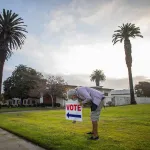We’re making sense of the midterms. Subscribe to our daily newsletter for election context and analysis.
Voters in California, Kentucky, Michigan, Montana and Vermont turned out in favor of abortion rights in Tuesday’s midterms, per projections from Decision Desk HQ.
When combined with this summer’s vote in Kansas, Tuesday set a record for the most abortion initiatives in a single election year.
After a decided victory for abortion rights in Kansas this summer, these midterms previewed more measures that could come in the next few years, as state lawmakers navigate what limits — or protections — they can place on abortion, and what must be put to voters. And they offered a clear indication that voters in both red- and blue-leaning states back abortion access
The surge in abortion measures came after the Supreme Court ruled this summer to overturn Roe v. Wade, eliminating federal abortion protections and letting states decide the procedure’s legality. Almost all of them asked voters to weigh in on state constitutions, which have taken on heightened significance since Roe was overturned: Every challenge to an abortion ban — including several that have temporarily blocked restrictions on the procedure — has been based on arguments over what is protected in individual state constitutions.
Most of these ballot measures were in the works before this summer, in anticipation of Roe’s eventual overturn. But they gained new traction since the court’s June 24 ruling, with advocates on all sides investing more time and money into bringing abortion rights to a vote.
“People were recognizing the importance of state constitutions,” said Elizabeth Nash, who tracks state policy at the Guttmacher Institute, a leading abortion policy research organization. “People were seeing the writing on the wall with the Supreme Court and wanted to either protect or deny rights in their state constitutions.”
Abortion initiatives are likely to remain a major election issue in the coming years. Lawmakers in Pennsylvania are proposing a constitutional amendment next year that would clarify the state does not protect abortion rights. Iowa lawmakers are eyeing a similar vote in 2024.
Meanwhile, reproductive rights organizations are trying to bring abortion rights constitutional amendments to 2024 elections in Oklahoma and South Dakota. Abortion is illegal in both states.
California
California passed a constitutional amendment that would enshrine the right to “reproductive freedom,” which includes abortion and contraception protections, Decision Desk HQ projects.
The state had already passed a law protecting abortion rights, but a constitutional provision holds more weight — unlike a law, it cannot be struck down by a state court, and it is harder to repeal. If successful, the measure would take effect the day after it is passed. So far, no state’s constitution explicitly protects abortion rights.
Supporters raised close to $15 million for the measure.
California, the largest state with legal abortion, has positioned itself as a haven for the procedure. But it’s not clear how many people are in fact able to travel to the Golden State for abortions. Abortions in California appear to have increased by only 1 percent since Roe v. Wade was overturned.
Michigan
In a hugely consequential victory for abortion rights advocates, Michigan voters will amend their state constitution to explicitly protect “reproductive freedom,” Decision Desk HQ projects.
The vote means that abortion will stay legal in the state. Right now, the procedure is available because a court temporarily blocked enforcement of a 1931 law that kicked in after Roe v. Wade was overturned. Tuesday’s election result means that Michigan will remain another state in the Midwest where abortion is protected.
In Michigan, a coalition supporting the state’s abortion rights amendment raised $44 million this election cycle, per state campaign filings; an anti-abortion coalition raised about $16.9 million in that time period.
A recent comparison of abortions performed in April and August of 2022 — before and after Roe’s overturn — showed that the number of abortions in Michigan has increased by 8 percent. That number could grow; nearby Ohio and Indiana have both passed laws banning most or all abortions, though the laws are currently blocked. Abortion is unavailable in nearby Missouri and Wisconsin.
-
Read Next:
Kentucky
In Kentucky, voters shot down a proposed constitutional amendment that would specify the state’s constitution does not protect the right to an abortion. Currently, abortion providers are suing in state court to block a total ban on the procedure, but the case is on hold until the election results come in.
The result was hailed by abortion rights organizers, who said it could strengthen the argument that abortion restrictions are unpopular in red states as well as blue ones. Kentucky is now the second conservative state to reject this style of proposed amendment; a similar initiative failed this summer in Kansas.
Organizations campaigning for and against Kentucky’s measure cumulatively raised more than $3 million, with most money going to abortion rights organizations.
-
Read Next:
Montana
In Montana, where abortion rights are protected by a 1999 state Supreme Court ruling, voters rejected a different, more confusing type of measure: a law requiring medical care be given to “infants born alive after an induced labor, cesarean section, attempted abortion, or another method.” The Montana measure defines “born alive” as any being that “breathes, has a beating heart, or has definite movement of voluntary muscles.”
The measure ostensibly has to do with abortion, though a fetus is rarely “born alive” after someone attempts to terminate a pregnancy, per data from the Centers for Disease Control and Prevention. A fetus becomes viable — meaning it can independently live outside the womb – after 23 to 25 weeks of pregnancy, which is well after most abortions occur. Currently, five clinics in Montana provide abortion, which is legal in the state up until fetal viability.
The Montana initiative came under criticism from the state’s medical organizations, which said it would compromise care for babies born incredibly prematurely or with fatal abnormalities. Experts said it could prevent health care providers from giving those newborns palliative care and potentially punish medical professionals for letting families hold infants before they die.
Some also say that proposals like Montana’s imply there is a prevalence of “born alive” fetuses after an abortion — an inaccurate characterization that they argue stigmatizes abortion or suggests that physicians won’t provide appropriate care for newborns without the threat of punishment.
“It is a way to try to couch abortion as dangerous and providers as unscrupulous. And in turn when you stigmatize abortion, you make it much easier to restrict and even ban it,” Nash said.
Vermont
Vermont amended its constitution to specifically protect “personal reproductive autonomy,” including the right to an abortion. Vermont is now one of two states in the country to pass a constitutional amendment addressing abortion rights, specifically. (In other states, state courts have interpreted other constitutional protections — such as a right to privacy or bodily autonomy — as extending to abortion.)
Since Roe was overturned, Vermont has seen a 10 percent increase in abortions performed. But overall, that still represents a small number. Only 20 abortions in total were done in-state in August.








